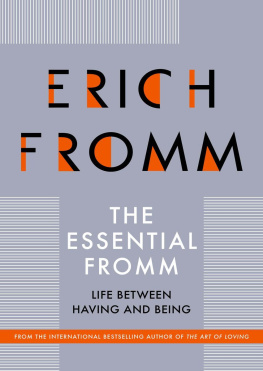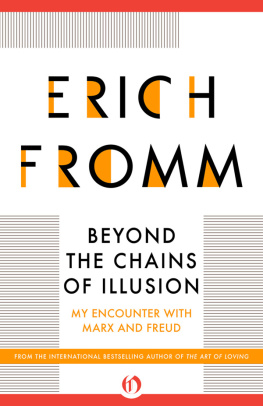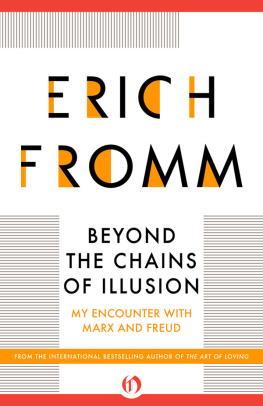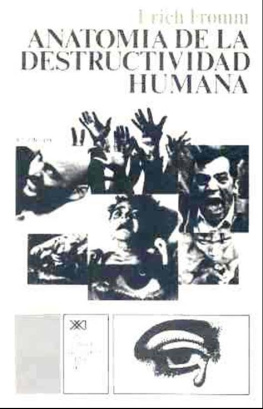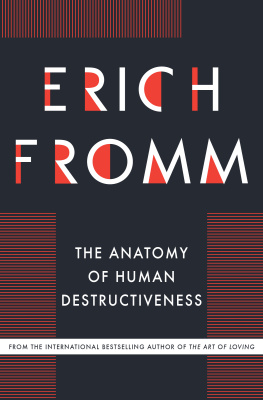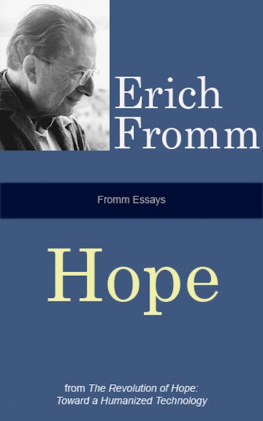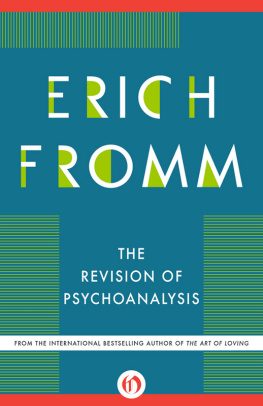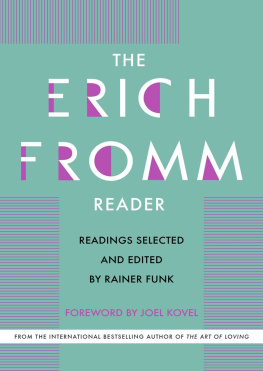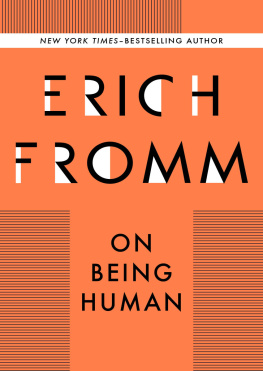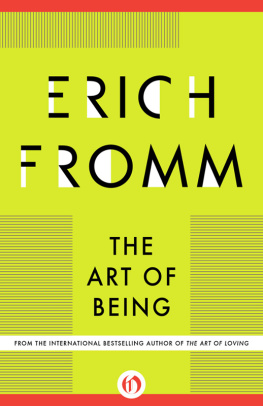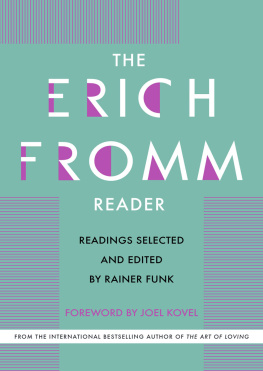Erich Fromm - The Essential Fromm: Life Between Having and Being
Here you can read online Erich Fromm - The Essential Fromm: Life Between Having and Being full text of the book (entire story) in english for free. Download pdf and epub, get meaning, cover and reviews about this ebook. year: 2000, publisher: Open Road Distribution, genre: Science. Description of the work, (preface) as well as reviews are available. Best literature library LitArk.com created for fans of good reading and offers a wide selection of genres:
Romance novel
Science fiction
Adventure
Detective
Science
History
Home and family
Prose
Art
Politics
Computer
Non-fiction
Religion
Business
Children
Humor
Choose a favorite category and find really read worthwhile books. Enjoy immersion in the world of imagination, feel the emotions of the characters or learn something new for yourself, make an fascinating discovery.
- Book:The Essential Fromm: Life Between Having and Being
- Author:
- Publisher:Open Road Distribution
- Genre:
- Year:2000
- Rating:4 / 5
- Favourites:Add to favourites
- Your mark:
- 80
- 1
- 2
- 3
- 4
- 5
The Essential Fromm: Life Between Having and Being: summary, description and annotation
We offer to read an annotation, description, summary or preface (depends on what the author of the book "The Essential Fromm: Life Between Having and Being" wrote himself). If you haven't found the necessary information about the book — write in the comments, we will try to find it.
The Essential Fromm: Life Between Having and Being — read online for free the complete book (whole text) full work
Below is the text of the book, divided by pages. System saving the place of the last page read, allows you to conveniently read the book "The Essential Fromm: Life Between Having and Being" online for free, without having to search again every time where you left off. Put a bookmark, and you can go to the page where you finished reading at any time.
Font size:
Interval:
Bookmark:
The Essential Fromm
Life Between Having and Being
Edited and with a foreword by Rainer Funk
CONTENTS
Editors Foreword
Our life is a life between having and being. This is the experience of many people who are moved by Erich Fromms alternative of having or being and who can be motivated to a change in their lives. Erich Fromm formulated the alternative in the book To Have or to Be? in 1976. In 1989, nine years after Erich Fromms death, this book was followed by another that bore the title The Art of Being (Continuum, 1992), which contained chapters from his posthumous writings that he had intended for the book published in 1976 but, for various reasons, did not publish at that time.
The alternative of having or being serves many people as a key to an understanding of what they value consciously, semiconsciously, or unconsciously and of what they actually pursue passionately in their lives. Not only does it allow one to understand conceptually and to diagnose what really goes on within each of us, but it is at the same time a viable guiding notion for changing our lives as well.
Whoever tries to discern his own orientation toward having and to practice an alternative with orientation toward being develops the need to learn even more about the path toward it. The present reader concerning the alternative of having or being hopes to meet this need. It does not seek to replace readings of the two books To Have or to Be? and The Art of Being, but rather to complement them. This results from the selection of the texts collected here as well as from the manner of their compilation. Moreover, The Essential Fromm: Life between Having and Being seeks to reduce the large number of misunderstandings surrounding the alternative of having or being and to pick out those aspects that, after a nearly thirty-five-year-long acquaintance with Fromms alternative, have proven to be especially fruitful and instructive.
Much of what is formulated in well-chosen words in the two books mentioned makes an impact only in the form of the spoken word. Lectures and interviews are thus an important complement and addition. Erich Fromm did indeed write all his books in English, but, when To Have or to Be? was being written during the 1970s, he gave a series of lectures in German and granted numerous German interviews. The transcripts of these interviews and lectures, which are otherwise inaccessible or accessible only with difficulty, make up a considerable part of the present volume.
The alternative of having or being as basic orientations of our passionate strivingsof our characterhad already been occupying Erich Fromm for many years before he dedicated an entire book to it at the end of his life. Prefigured by Meister Eckhart and Karl Marx (cf. E. Fromm, On Being Human, 1992b), he conceived of them in the 1940s as an alternative between nonproductive and productive character orientation, later as an alternative destructiveness, i.e., necrophilia, and creativity, i.e., biophilia (cf. E. Fromm, 1964a). There are statements and lectures about these alternatives as well that illustrate exactly what Fromm means by the being mode of existence. Because they, too, are largely unknown, they were included in this volume.
Finally, this volume contains several key sections from the two books To Have or to Be? and The Art of Being, which are of particular importance for the question of living between having and being and the question of the path to an orientation toward being; this volume also contains a previously unpublished manuscript for To Have or to Be?
The texts for the present volume were selected in such a way that their sequence and entirety constitute a rounded whole. Each selection and compilation of the texts pursues particular interests. One interest was to clarify life between an orientation toward having and an orientation toward being. Thus, the chapter Essentials of a Life between Having and Being is a key part of the present volume. Very definite manifestations are characteristic of the orientation toward having as well as of the orientation toward being. In such cases, distinctions were made between the typical, direct manifestation of the orientation toward having and the compensatory manifestations that are characteristic of it.
| Joy of life is typical of the person who is oriented toward being. A person who is oriented toward having, in contrast, feels depressive and is afraid to lose his or her self, and thus tends to compensate this loss primarily through obsessive forms of consumption. |
| Whoever is oriented toward being is productively active and lives from an inner activity, while the person who is fixated on having is determined by an odd passivity; in reality, he is living vicariously. In order to avoid this passivity, many people flee into busybody activity. |
| Creativity is always a characteristic of orientation toward being; corresponding to this is the endless boredom of the person who is oriented toward having, a boredom that is compensated for primarily by activities in which something still happens: by action, violence, and destructiveness. |
| Experiencing ones self through ones own powers means the same as being oriented toward being; in contrast, the person who is oriented toward having is always fighting against a threatening loss of self that he attempts to ward off by narcissistic pomp. |
| A humanistic religiosity directed against any type of reification, quantification, and idolatry of man is typical for any orientation toward being, while the person who is oriented toward having is characterized by a profound disbelief for which he tries to compensate with appropriated concepts of God or the gods of the Industrial Age. |
| A love of life is the mark of all productive powers that are oriented toward being, while the person who clings to having develops panic anxieties of any separation. The fact that he will one day also be separated from life produces in the having-oriented person a characteristic fear of death, which usually manifests itself defensively as a denial of death, as a belief in immortality, or as a fascination with death and that which can no longer die. |
In To Have or to Be?, Erich Fromm discussed additional characteristics under the heading Further Aspects of Having and Being.
The last chapter of the present collection, which deals with the Steps toward Being, is another key point. Although important Steps toward Being were described in The Art of Being, that book gives but little attention to the fact that the steps toward being have to do with changing the bent of a persons character structure and its conscious and unconscious aspects. For this reason, the present volume also contains texts pertaining to the question of characterological change and the unconscious.
An especially relevant interest reflected in the selection and compilation of the texts of this volume is the attention drawn to human alienation through the market economy, which has led to the cultivation of the marketing character. It is indeed true that the orientation toward having is characterologically related to an anal-hoarding possessiveness that seeks to acquire things only egoistically and selfishly and that does not want to give or share anything. Yet possessiveness is only one root of the orientation toward having. As Erich Fromm himself shows in part 3 of To Have or to Be?, the orientation toward having is today far more the result of alienation caused by the marketing character. This is characterized by the fact that a person must surrender and lose more and more of his self and his individual being if he wants to be successful in the marketplace. He increasingly perceives himself as a vacuous subject that is then forced to replace his individual and subjective being with the possession of objects.
Next pageFont size:
Interval:
Bookmark:
Similar books «The Essential Fromm: Life Between Having and Being»
Look at similar books to The Essential Fromm: Life Between Having and Being. We have selected literature similar in name and meaning in the hope of providing readers with more options to find new, interesting, not yet read works.
Discussion, reviews of the book The Essential Fromm: Life Between Having and Being and just readers' own opinions. Leave your comments, write what you think about the work, its meaning or the main characters. Specify what exactly you liked and what you didn't like, and why you think so.

